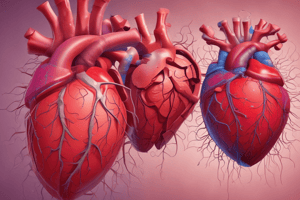Podcast
Questions and Answers
What is myocardial infarction (MI) defined as?
What is myocardial infarction (MI) defined as?
- Irreversible myocardial damage due to sudden coronary artery occlusion (correct)
- Reversible myocardial damage due to sudden coronary artery occlusion
- Myocardial damage due to chronic coronary artery occlusion
- Reversible myocardial damage due to chronic coronary artery occlusion
Which of the following is NOT a risk factor for myocardial infarction?
Which of the following is NOT a risk factor for myocardial infarction?
- Diabetes mellitus
- Hypertension
- Regular exercise (correct)
- Stressful life
What is the most common site of transmural infarction?
What is the most common site of transmural infarction?
- Right ventricle
- Posterior surface of left ventricle
- Left ventricle (correct)
- Lateral surface of left ventricle
What is the main cause of acute coronary artery occlusion?
What is the main cause of acute coronary artery occlusion?
What is the consequence of irreversible myocardial damage?
What is the consequence of irreversible myocardial damage?
What is the specific enzyme change in myocardial infarction?
What is the specific enzyme change in myocardial infarction?
What is the most common complication of myocardial infarction?
What is the most common complication of myocardial infarction?
What is the characteristic ECG change in myocardial infarction?
What is the characteristic ECG change in myocardial infarction?
What is cardiac tamponade caused by?
What is cardiac tamponade caused by?
Which of the following is a major risk factor for atherosclerosis?
Which of the following is a major risk factor for atherosclerosis?
What is the main component of atherosclerotic plaques?
What is the main component of atherosclerotic plaques?
According to the endothelial injury theory, what is the result of physical and chemical trauma on endothelial cells?
According to the endothelial injury theory, what is the result of physical and chemical trauma on endothelial cells?
What is the result of the migration of smooth muscles from the media to the intima in the smooth muscle proliferation theory?
What is the result of the migration of smooth muscles from the media to the intima in the smooth muscle proliferation theory?
What is the gross picture of atherosclerotic plaques in large and small arteries?
What is the gross picture of atherosclerotic plaques in large and small arteries?
What is the composition of the central necrotic zone of an atheroma?
What is the composition of the central necrotic zone of an atheroma?
What is the consequence of fissuring, calcification, or ulceration of atheromatous plaques?
What is the consequence of fissuring, calcification, or ulceration of atheromatous plaques?
Flashcards are hidden until you start studying
Study Notes
Myocardial Infarction (MI)
- Definition: Irreversible myocardial damage due to sudden coronary artery occlusion
- Risk factors: Hypertension, Diabetes Mellitus, Smoking, Hyperlipidemia, Old age, Male gender, Family history, Stressful Life
Types of MI
- Trans-mural infarction:
- Affects the full thickness of ventricles
- Due to atherosclerosis superimposed by thrombus formation
- Usually affects the left ventricle, but the right ventricle can be affected rarely
- Sub-endocardial infarction:
- Limited to the inner 1/3 of the ventricular wall
- Sites of coronary occlusion include:
- Anterior descending branch of the left coronary artery, leading to infarction at the anterior surface of the left ventricle
- Lateral circumflex branch, leading to infarction at the lateral surface of the left ventricle
- Right coronary artery occlusion, leading to infarction at the posterior surface of the left ventricle and posterior portion of the interventricular septum
Causes of Acute Coronary Artery Occlusion
- Thrombosis on top of atherosclerosis
- Polyarteritis nodosa (PAN)
- Emboli
Pathogenesis of MI
- The major cause of MI is coronary atherosclerosis (atheroma)
- Hemorrhage, ballooning, and fissuring of atheroma lead to vascular occlusion and MI
- Non-complicated atheroma occludes 75% of the cross-diameter of the affected vessel
- If occlusion persists for more than 20 minutes, irreversible myocardial damage occurs
Pathology of MI
- The trans-mural infarct undergoes a characteristic sequence of gross and microscopic changes
Diagnosis of MI
- Clinical: Chest pain, dyspnea, and arrhythmia
- ECG: Elevated ST segment and inversion T wave
- Enzyme changes:
- Increased CPK (Creatine Phosphokinase) - specific, peaks at 24 hours, and falls in 3 days
- Increased LDH (Lactic Dehydrogenase) - peaks at 48-72 hours, and falls in 7-10 days
- Increased SGOT (Serum Glutamic Oxaloacetic Transaminase) - not specific
- Leucocytosis
Complications of MI
- Arrhythmia (90%)
- Cardiogenic shock
- Ventricular aneurysms
- Mural thrombosis
- Rupture causing cardiac tamponade
- Congestive Heart Failure (CHF)
- Sudden death
Atherosclerosis
- Definition: Chronic degenerative disease of arteries characterized by raised yellowish-white sub-intimal plaques formed of lipid deposition, proliferated smooth muscle cells, and extracellular matrix
- Risk factors:
- Major: Hypertension, Smoking, Diabetes Mellitus, Hyperlipidemia
- Minor: Obesity, Old age, Male gender, Sedentary and stressful life, Oral contraceptive pills, Positive family history
- Pathogenesis:
- Endothelial injury theory: Physical and chemical trauma leading to endothelial cell injury, increase in endothelial permeability to lipids, platelet and monocyte activation, and macrophage engulfing lipids
- Smooth muscle proliferation theory: Migration of smooth muscles from media to intima, followed by proliferation and synthesis of extracellular matrix
- Pathological features:
- Sites: Large arteries (aorta and its main branches) and small arteries (coronary, cerebral, retinal, and renal)
- Gross picture: Raised yellowish-white atheromatous plaques (1-1.5 cm) in large and small arteries protruding into the vascular lumen
- Complications: Fissuring, calcification, or ulceration leading to thrombosis and vascular occlusion
- Microscopically: Atheroma is composed of superficial fibrous cap, cellular zone, central necrotic zone, and internal elastic lamina
Studying That Suits You
Use AI to generate personalized quizzes and flashcards to suit your learning preferences.



